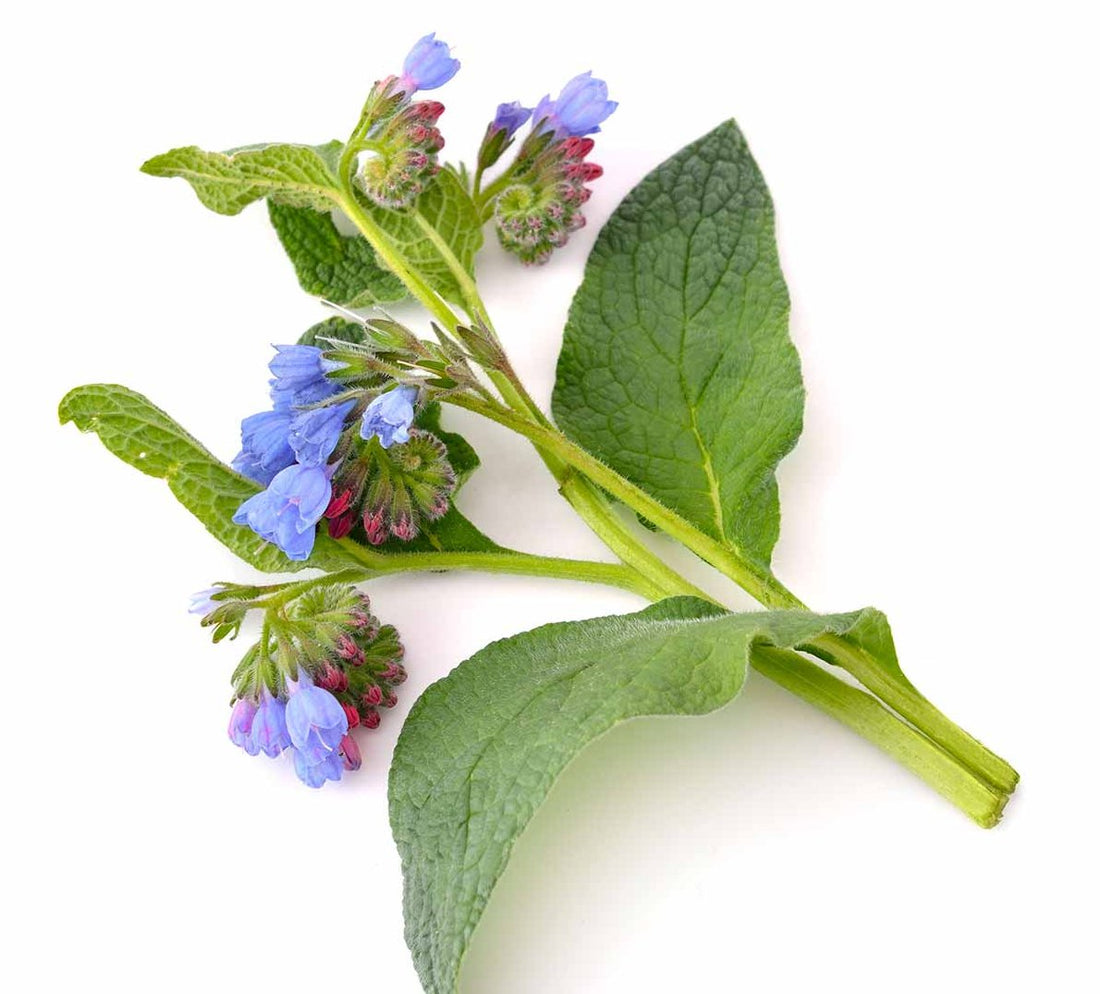Comfrey - A Touch of Silk!
Let me introduce you to this stunning plant which I grow specifically for use in our Skyezone skin care products. Used for centuries for its medicinal properties, including its ability to heal wounds and reduce inflammation, Comfrey Symphytum officinale, has very deep roots, which draw a spectacular array of nutrients from the soil.
Our focus here, is on its ability to store allantoin (a-lan-tone) & rosmarinic (ros-mar-in-nic) acid in its roots.
The majority of allantoin used in consumer skincare products is synthetically produced…. not so at Skyezone, where it’s grown & processed with enthusiasm! Here’s why:
Allantoin (allan-toy-n)is a versatile compound that works in synergy with vitamins and other elements to boost the efficiency of creams, lotions, serums, and masks. Comfrey helps to support different skin concerns while providing overall skin health. You can feel the the difference its silky texture imparts to lotions and it leaves your hair with bounce and a softer silky texture.
Comfrey produces the highest percentage of allantoin of the 3 main plants that produce it, providing 6 times that found in chamomile, and wheat sprouts. Now in my 70’s I personally couldn’t be without these comfrey enhanced skincare products (which I formulated over the past 15 years) and continue to marvel at the potency of this herb. That’s good because processing it is quite an exercise, as you’ll see below.
Comfrey contains:
1)Vitamins: Comfrey contains vitamins A, B1, B2, B3, B5, B6, B9, B12, C, and E.
2)Minerals: Comfrey also contains phosphorous, potassium, calcium, magnesium, manganese, boron, chromium, cobalt, copper, iodine, iron, selenium, sodium, and zinc.
3) Allantoin: Comfrey contains allantoin, which helps new skin cells grow and reduces inflammation.

Here are the key attributes that allantonin, derived from comfrey root, brings to each product.
|
4 Key Benefits |
Example Products |
|
1. Skin-soothing, anti-inflammatory Allantoin (and especially its rosmarinic acid) possess anti-inflammatory properties that help calm and soothe the skin. Helping to reduce redness, irritation, and inflammation, make it particularly beneficial for sensitive or easily irritated skin types. |
|
|
2.Moisturizing & hydration Comfrey root is a natural humectant, which means that it helps attract water to the skin. This aids hydration and prevents the skin from becoming dry, itchy, and flaky. Skin hydration ensures softer, smoother, and more supple skin, nice! |
|
|
3.Antioxidant & Anti-aging |
|
|
4. Cell- Regeneration & Collagen |
|
- Dig up the root in mid-to-late winter (once the leaves die back.)
- Wash several times then peel off the black outer skin.
- Cut into small pieces and simmer 10 mins in just enough water to cover.
- Pulp all juice and comfrey pieces, removing any black flecks.
- Dry the pulp on trays.
- Grind the dried pulp to a fine powder.
- Date & store in the freezer.
- Reconstitute for use at % required for product (3-20%) in distilled water or hydrosol


Why not grow your own comfrey plant.
Comfrey is a perennial (re-grows each year) which grows easily from root pieces, even if they have been cut and simmered for 10 mins. Now that’s determination! The leaves are high in nutrition and like spinach can be steamed or fried in a light egg batter. The fine hairs on the leaf can cause irritation, so don’t eat them raw, or handle without gloves. Cooking eliminates those fine hairs and when eaten it can help as a digestive binder and tissue repair throughout the body. Respect powerful herbs and consume in moderation, a leaf a day or a few cooked as greens once a week.
Comfrey acts as a soil improver and companion plant because its deep root system draws nutrients up to the root zone of most other plants to access. Please note that it is hard to remove once established (it goes deep!) It prefers wetter soil and needs shade from hot summer sun. It will spread quite easily over several years, with the leaves dying back in winter to re-emerge in spring. Bees love comfrey flowers which can be white, pink, lavender or blue. Enjoy your comfrey!
![]() Published July 2023
Published July 2023







